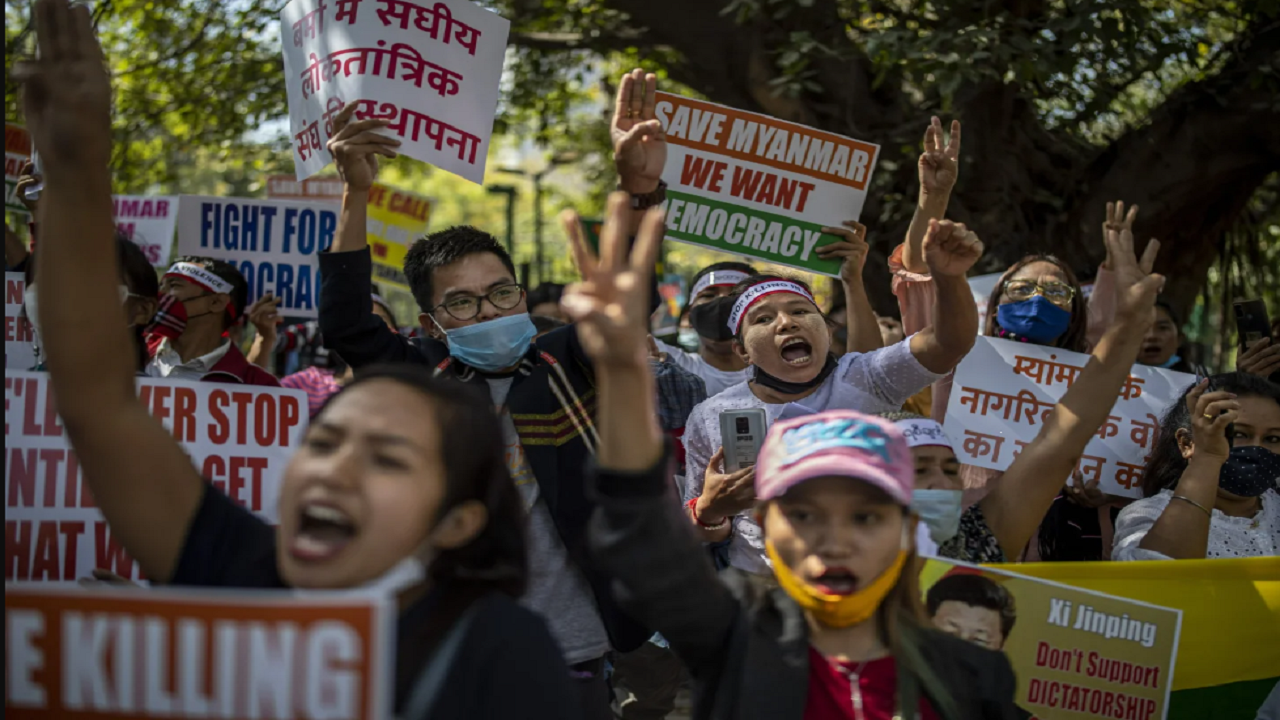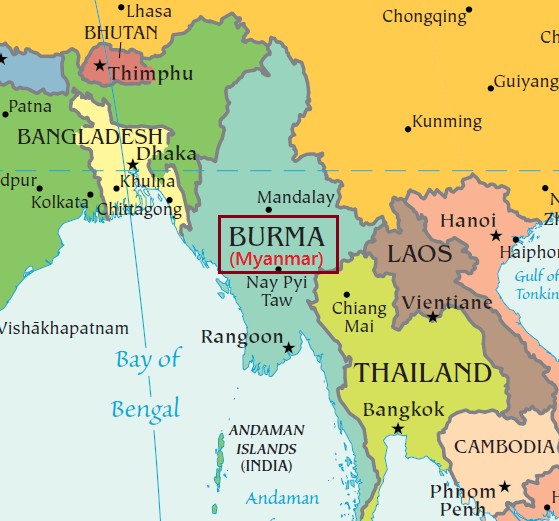Myanmar’s Future Is Uncertain: Can India Be Of Help?
Around 5,000 refugees – apart from the 75,000 refugees already in India - that have recently crossed over into Mizoram and Manipur that share a 1600 km long border. Myanmar also has a 2100 km border with China.

Myanmar refugees in India (File ndia)
Photo : AP
The violence in Myanmar followed by an influx of refugees into India’s north east region cannot be ignored as India’s strategic interests in Myanmar are many, should Delhi care to look at the challenges other than those posed by China and Pakistan. Though small in numbers yet, 5,000 refugees – apart from the 75,000 refugees already in India - that have recently crossed over into Mizoram and Manipur that share a 1600 km long border. Myanmar also has a 2100 km border with China, which has strategic investments in that country. Myanmar – earlier Burma- has been subjected to tragic cycles of violence, largely led by their Military Junta.
A history of Civil wars
Since gaining independence from the British in 1948, a protracted civil war has continued between Myanmar’s central authorities and the myriad of armed ethnic groups who faced oppression at the hands of the rulers ensued well into the 1990s. With a relative pause for a few years in these internecine battles, Myanmar was slowly attempting to transition towards a democracy. And then a coup happened that pushed the country on the brink of internal rebellion again, but this looks like a different animal altogether. The State Administration Council (SAC) led by the Myanmar’s Tatmadaw organised a coup in the country in February 2021, and ousted Aung San Suu Kyi’s civilian leadership of National League for Democracy government.
By November 2023, there had been but a series of missteps that has exacerbated the internal revolt from the oppressed ethnic groups who also are beholden to their armed militia groups which has really rattled the de facto leader army general Min Aung Hlaing’s tenuous grip over power in the embattled country. The army has been on the run. The state sanctioned Rohingya pogrom which reached its peak in 2017 and the subsequently forced exodus was just the starting point of the collective and ominous rebellion that has brought the country on the verge of fragmentation if the conflict between Myanmar’s military and the allied and armed ethnic groups continues unabated. The cursory international rebuke has no bearing on the impunity with which the common Myanmar’s citizen has been brutalized by its own military.
To put the ensuing dangerous escalation into perspective, on 27 October, the Three Brotherhood Alliance, comprising Arakan Army (AA), Myanmar National Democratic Alliance Army (MNDAA), and Ta’ang National Liberation Army (TNLA), launched Operation 1027 in the north-eastern Shan state of Myanmar bordering China and this was followed by simultaneous attacks in the state of Rakhine. Incidentally, the ranks of the Brotherhood alliances were boosted by fighters from the same beleaguered Rakhine state as well.
What the people want
What are the demands of the people? The restoration of democracy which has been eroded since the military seized power in a coup in February of 2021. And their statement states this clear intention, “The operation was driven by our collective desire to safeguard the lives of civilians, assert our right of self-defence, maintain control of our territory, and respond resolutely to ongoing artillery attacks and airstrikes from the Myanmar military.” “It is dedicated to eradicating the oppressive military dictatorship, a shared aspiration of the entire Myanmar populace.”
It has been a brutal round of attacks and counter attacks between the two warring sides, and the impact of it is being felt on the ground as the Myanmar military has lost control of several towns and over 100 security outposts, leading to the declaration of martial law in eight townships near the Chinese border. And consequently, the army (Tatmadaw) has unleashed a new wave of massacres by firing artillery on ‘terror targets’ and also using air power against them. The rebel alliance has seized over 8,000 sq kms of land, which is also to say that the army (Tatmadaw) never actually had full control over regions of its own country even before the rebellion started.
Rebels take control
These fast advances were made in waves, strategically raiding and occupying the areas under the junta’s control. This was followed by a second wave of attack that happened on November 7, ‘Operation 1107’, in which the Karreni resistance forces captured at least two military bases in the south eastern Kayah State. Operation 1107 was launched to liberate Kayah State and support the resistance’s advance to Pyinmana, near the junta’s Naypyitaw fortress. India cannot have another bordering country to its east fall deeper into turmoil; as stakes for India’s internal security are too high, especially in the sensitive and volatile north east. And early next year India goes to the polls and any further build up volatility could spill over into India’s already uneasy neighbourhood just as we can observe the precarious political situation in Bangladesh as the country goes to polls next January.
Coming back to the impact on India’s north-eastern Border States. The evolving conflict is raising prospects of growing unease, particularly in the states of Manipur and Mizoram that border northern Myanmar. Over 31,000 Myanmar nationals have taken shelter in Mizoram since the coup of February 2021.
India’s boundary woes
A blunt analysis from a former general summarizes the intricacies of this conflict. “The military of Myanmar has battled insurgencies for many years, but after a coup in 2021, anti-military forces began to collaborate in a way that had never been seen before, putting the army to its biggest test to date,” Major General SB Asthna (Retd), at the USI (United Service Institution, Delhi), opined. "The ethnic armies that collaborated with the PDF have become more powerful, expanding their sphere of influence and commencing to work together to put pressure on the military from all directions. They have also increased the intensity of their attacks against the Myanmar military and taken control of several Myanmar posts. Consequently, a few Myanmar soldiers decided to flee and made it to India."
"India prefers a democratically governed, stable Myanmar; an unstable Myanmar does not suit India. Likewise, Myanmar is also in a strategic position to support all of India's initiatives with the nations of Southeast Asia. In the event that India needs to connect by road, the route passes through Myanmar. So, therefore, Myanmar becomes important to India," the general further elaborated.
Map Of Myanmar with northeast India:

Mizoram shares a 510 km porous border with Myanmar. The rebel alliance has captured two towns along the Indian border – Rikhawdar in Chin and Khampat in the Sagaing region. These towns are vital for India’s trade with Myanmar and also perhaps in the future routes expanding from these ones could make wider connections with Southeast Asian countries. India is rightly worried about the ensuing offensive in the Chin state as the rebellion there was backed by locals in Mizoram, as they maintain close ethnic ties, and tens of thousands of people from Myanmar have sought refuge from the raging violence, including the exiled state and federal representatives. With Manipur already going through an uneasy calm, another north-eastern state like Mizoram with the influx of refugees from Myanmar poses another set of security and humanitarian challenges for the government at the centre.
India has called for the cessation of hostilities. "We reiterate our call for the return of peace, stability and democracy in Myanmar," India's Foreign Ministry spokesperson Arindam Bagchi told reporters. "As a result of the fighting in Rihkhawdar area in Chin State, opposite Zokhawthar in Mizoram on the India-Myanmar border, there has been movement of Myanmar nationals to the Indian side. We are deeply concerned with such incidents close to our border," Bagchi said in a recent media briefing. The current situation in Myanmar is highly fluid and complex and nobody, at least for now, can ascertain which party will come out on top in this seemingly intractable internal rebellion that has engulfed Myanmar.
Strangely despite India’s advocacy of democracy, New Delhi has chosen to deal with the anti-democracy Myanmar’s military, (known as Tatmadav) supplying them most recently arms worth $50 million, and support for their local political initiatives. In a set of cold calculations: New Delhi has chosen to deal with the Myanmar military instead of pro-democracy groups, as this provides Delhi better security options. Even the Defence Secretary of India paid a visit to Myanmar. India’s strategic interests are threefold: a) border security, more so in the light of the ongoing tensions in Manipur, b) India’s economic interests in this resource rich region, making it a key to India’s eastward agenda – BIMSTECH and MGC – in the Bay of Bengal. But c) driven as so many geo-strategic interests are, the aim is to counter China's interest in this country that allows huge access to the Bay of Bengal region.
Indian advisers had helped to draft the Burmese constitution in 1948, just as the British had left Burma. But today, the mess in Myanmar isn’t going to be resolved anytime soon. A beautiful country, but it’s a tragic nation, for now.
End of Article
Subscribe to our daily Newsletter!
Videos





03:53
Urfi Javed Flaunts her Topless Style | Jennifer Mistry's HEARTWARIMNG note for TMKOC

04:45
'World Used Kashmir Against India': What EAM Said On J&K's Art 370| Page From Times Now Archive

02:59
Breaking News: SC Upholds Abrogation Of Article 370 | No Special Status For J&K | Latest Updates

04:35
NC, PDP, And BJP Reacts On Abrogation Of Article 370 | Will Centre Be Vindicated? | Latest News

02:42
Israel Hamas War | Netanyahu Says 'Hamas Is Surrendering' | What's Happening In Gaza? | World News














